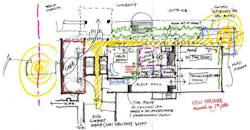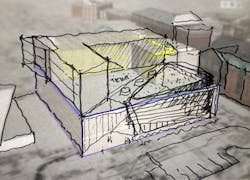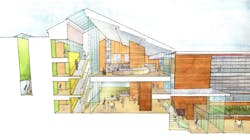Drawing. We’ve all done it. So why is it the exception not the norm in design today?
Architecture and design schools have, for the most part, stopped teaching hand drawing, so students don’t regard it as an integral part of the thinking process. Now that computers can create just about any virtual and real-looking environment, drawing is perceived as old-fashioned and slow. Contemporary culture pushes us to celebrate the newest approaches and the latest and greatest gadgets, devices and software. This is unfortunate, because while drawing currently resides on the “out” list, it should be a go-to tool for all designers. Instead it’s become the refuge of senior designers like me, who still appreciate drawing’s capacity to incite creative thinking and engender high levels of understanding.
Early stages of the design process can and should be messy. It’s important to churn through many prototypes as you see what ideas emerge. During a client visioning session, as ideas are discussed I draw them for the group. In these dynamic sessions, the real-time reaction and input moves the conversation and creative process at speeds not possible with computer drawings. Away from our offices and their sophisticated rendering software, with just a black felt-tip pen, I can demonstrate multiple design options to clients.
Hand-drawn concepts engage the group and spark discussion. When I talk about a concept using a sketch, the passion, mood and feeling communicated by the image complements the emotion of my voice. This builds a stronger connection between the design and the audience. That connection always trumps technology.
Drawing connects with people at an emotional level. This series of sketches quickly traveled from my mind, to my hand, to the paper, and now you are seeing the journey through my eyes. The same views generated by the computer would not impart the same emotional responses or convey my particular point of view as effectively.
Even the simple act of tracing holds tangible value. The above picture might make you want to laugh, but using trace paper over a screen lets me iterate options at lightning speed. Especially in the early design stages, time is of the essence. Only my hand can keep pace with the thought process.
Don’t get me wrong, I am not against technology; it has its place in the creative journey. Consider these studies, which help explain the massing evolution. Rational drawings like these, with precise measurements, have a short-lived use, but complement looser drawings and studies.
While a pen sketch effectively communicates my design solution, in some cases I turn to pencil and watercolors. The soft and appealing nature of this medium pulls the audience into the process. Its painterly style evokes emotion. By leaving certain areas unfinished, there is room for the viewer to use their mind’s eye. They can complete the picture in their own way. This harkens back to the title: seeing through the hand. This leaves certain pieces up to the imagination. And isn’t that what design is about?
As humans we all yearn for authenticity. A design process that starts with the hand, akin to the first brush strokes on a canvas, humanizes the process and establishes a strong foundation for the later stages where computer generated precision takes precedence. So while drawing is paramount to my process, technology also plays a leading role. But starting at a computer would be like putting the cart before the horse.
About the Author: Alex Fernández is a Principal and Design Director for Gensler’s Boston office. With a relentless passion for art and design, he inspires his teams through thoughtful, well-crafted design solutions. Explore the world through Alex’s hand and eyes on his website. Contact him at [email protected].
About the Author
Gensler
A global design firm with more than 5,000 practitioners networked across five continents, Gensler features insights and opinions of architects and designers on how design innovation makes cities more livable, work smarter, and leisure more engaging. Our contributors write about projects of every scale, from refreshing a retailer’s brand to planning a new urban district, all the while explaining how great design can optimize business performance and human potential. For more thought leadership and blog content, visit our Research & Insight page. Follow us on Facebook, LinkedIn, and Twitter.





